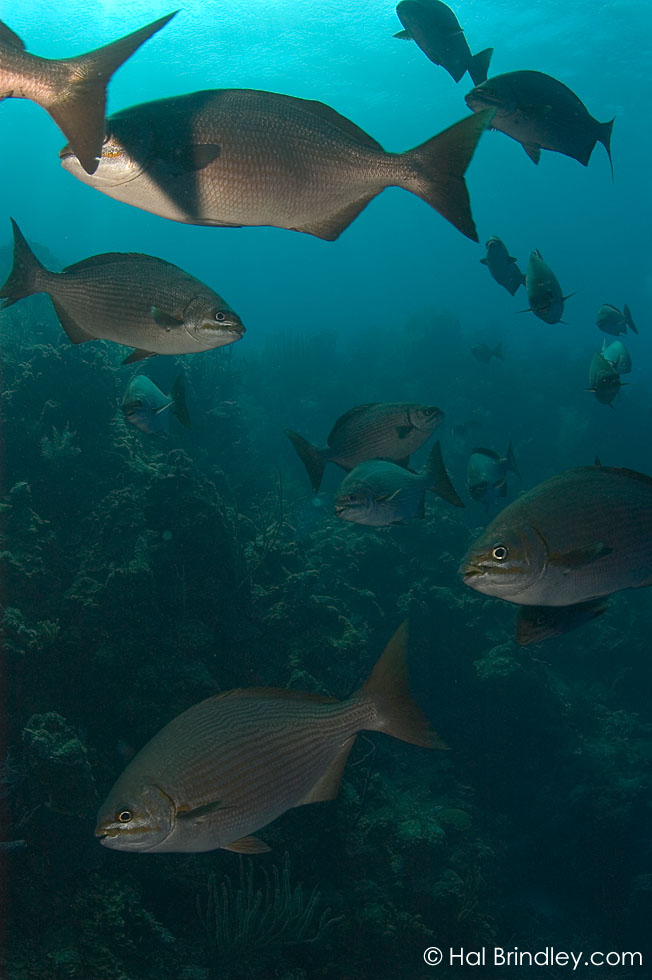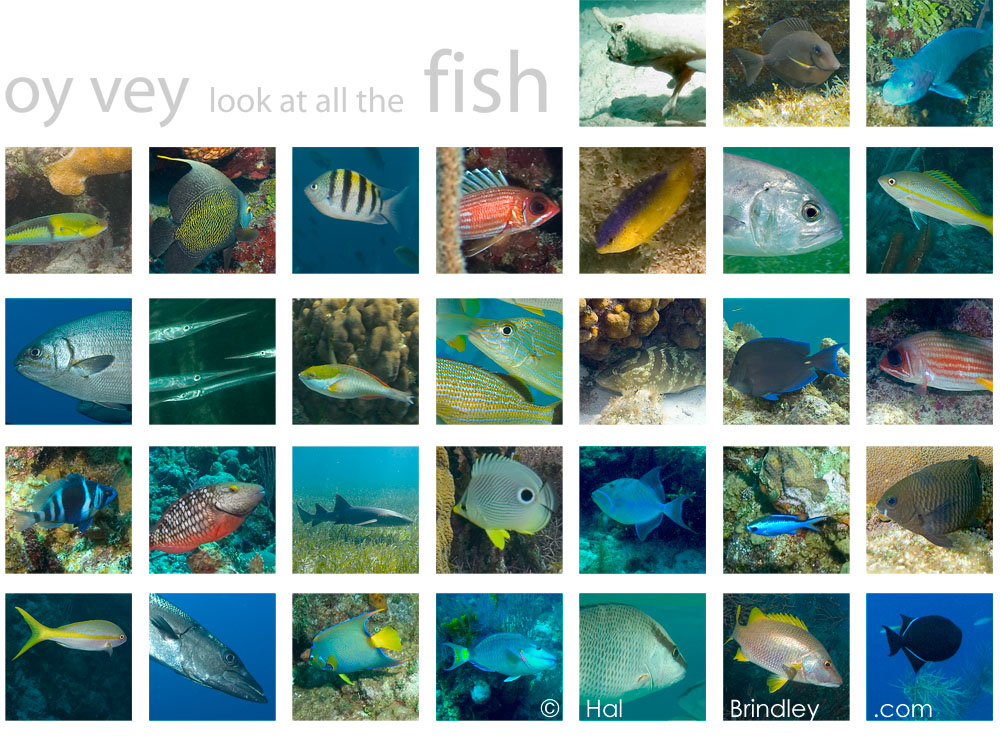Welcome to Belize, a tiny country in Central America nestled snugly on the Atlantic coast beneath Mexico. It’s smaller than New Hampshire and has a population equal to the town of Raleigh, North Carolina. You could call it a backwater except for the fact that a quarter of a million tourists arrive each year.
There’s a good reason for that; amazing coral reefs, tropical islands, large tracts of jungle, people who speak English, and a laid back Caribbean lifestyle.
How laid back? This store, next door to our hotel on Caye Caulker, is what qualifies as elegant in Belize. My kinda place.
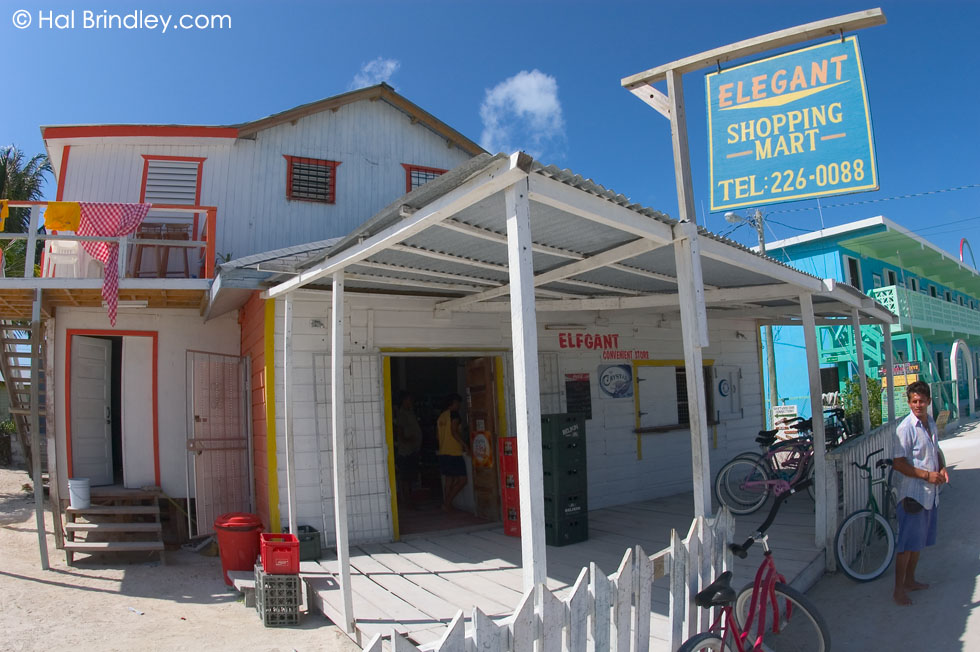
I got this crazy idea in my head that I wanted to be an underwater photographer. Where to go? I figured underwater would be a good place to start. I also had heard that coral reefs were pretty neato.
Everyone seems to know the world’s longest barrier reef is in Australia, the Great Barrier Reef. But I’m a tight-wad so I opted for something closer: the world’s second longest barrier reef, which is right next door off the coast of Belize. At 160 miles long it is nothing to scoff at.
How to get underwater to take pictures? I can’t seem to stay underwater for more than a minute without drowning. A Self Contained Underwater Breathing Apparatus of some sort would be helpful.
So I opted for SCUBA. Watching the PADI training tapes you get the feeling that you’re joining some sort of creepy brainwashing cult (“Fact: scuba divers are always happy” says the video)
Speaking of brainwashing, this is a picture of a brain coral. Underwater. I crack myself up.

Guess what I saw?
Fish. Lots of fish. Lots and lots of fish. I saw coral too. But you know what I saw a whole lot of?
Fish. This was one of my favorite moments, swimming through a school of Sergeant Majors. It was like being attacked by a swarm of cute little killer bees.

My goodness, the fish. If you’re getting the strange feeling that I don’t have much to say about fish it’s because I don’t.
This is my first time underwater, cut me some slack. They’re wet and scaly and they swim around. And they come in a stunning variety of shapes and colors and sizes.
As a wildlife photographer I almost pee my pants when I see a new species for the first time. This happens about 2 or 3 times a year if I’m lucky.
Getting under the ocean, it is like I have slipped through a portal to a different planet and I am starting from scratch. Everywhere I look is a species I have never ever seen.
As a result I am constantly peeing my pants, Which is perfectly acceptable when you’re underwater.
Oy vey. Look at all the fish.
Fish aren’t all cute and cuddly like Nemo the clownfish. Some will kill you. Take sharks for example.
Others, like the Great Barracuda here, can give you a good slashing if you’re not careful.

They have a mouthful of blade-like, razor sharp teeth and like to hang around divers and grin maniacally. I’ve read they are attracted to shiny objects like jewelry.
Although there have only been 19 confirmed barracuda attacks in the past 100 years, I still find myself checking my hands for rings when I see one swimming by. I don’t even own any rings.
Yes, I’m paranoid. I like my fingers, thank you very much.
You feel like Alice in Wonderland the first time you explore a coral reef. For example, you’re swimming over a beautiful garden of brightly colored plants anchored to stone, swaying in the breeze.
Only it turns out they’re not plants. They’re animals, like sponges and sea fans and hydroids and bryozoans and other such nonsense. Then it turns out it’s not rock they’re anchored to. It’s the skeletal remains of another animal, coral. To top it all off you realize there’s no breeze because you’re underwater, doofus.
My preliminary research tells me this is a photo of a hippopotamus upholstered in orange-velvet bubble wrap.
I think I’m going to need a few more biology lessons to get a real grasp of what’s going on down here. Until then I’ll be satisfied with giggling at names in my field guide like Sea Squirt and Nudibranch. The rest is a bunch abalone as far as I’m concerned.
There are some other, more recognizable creatures down there as well. Here’s a Spiny Spider Crab hiding inside a vase sponge.
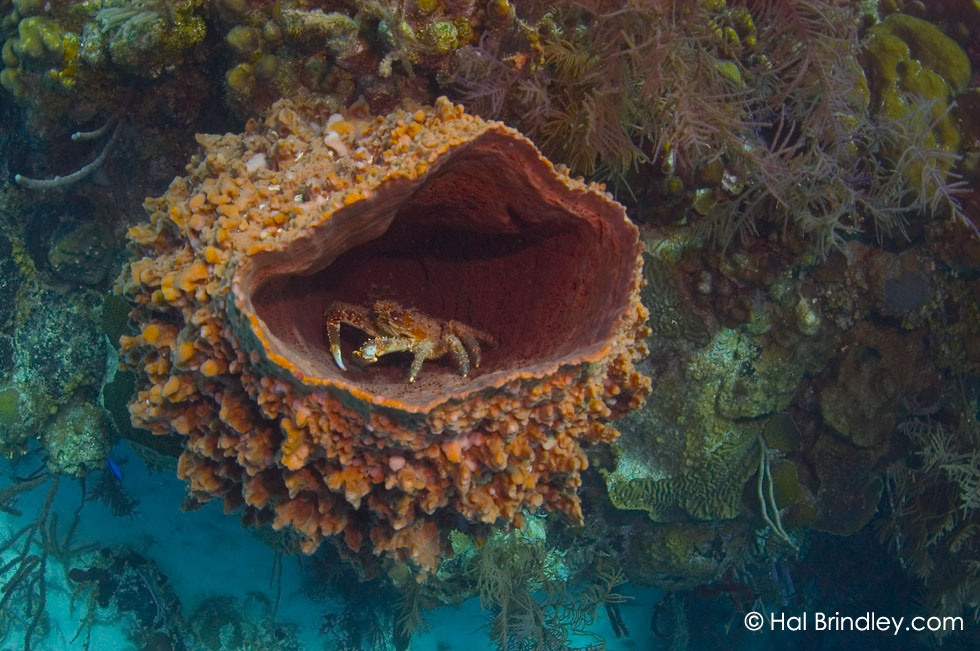
I spotted this Spotted Moray peeking out of its hole while doing a wall dive around the Turneffe Islands; a coral atoll twenty miles off shore.

An atoll is a ring of coral with a shallow lagoon in the middle where an island used to be.
A wall dive is where you swim along the sheer cliffs surrounding an atoll while trying not to look down at the dark abyss 10,000 feet below you.
Mangroves play a very important role in coastal ecology. This single specimen harbors hundreds of young fish within the embrace of its stilt-like root system.
![Blue Striped Grunt [?] (Haemulon sciurus) Location: The Split, Caye Caulker, Belize](http://www.halbrindley.com/wp-content/uploads/2005/02/10_big.jpg)
Let us now emerge from the water, as our wet, scaly ancestors did so long ago, and begin our journey inland. Through the mangrove fringe and into the rainforest.
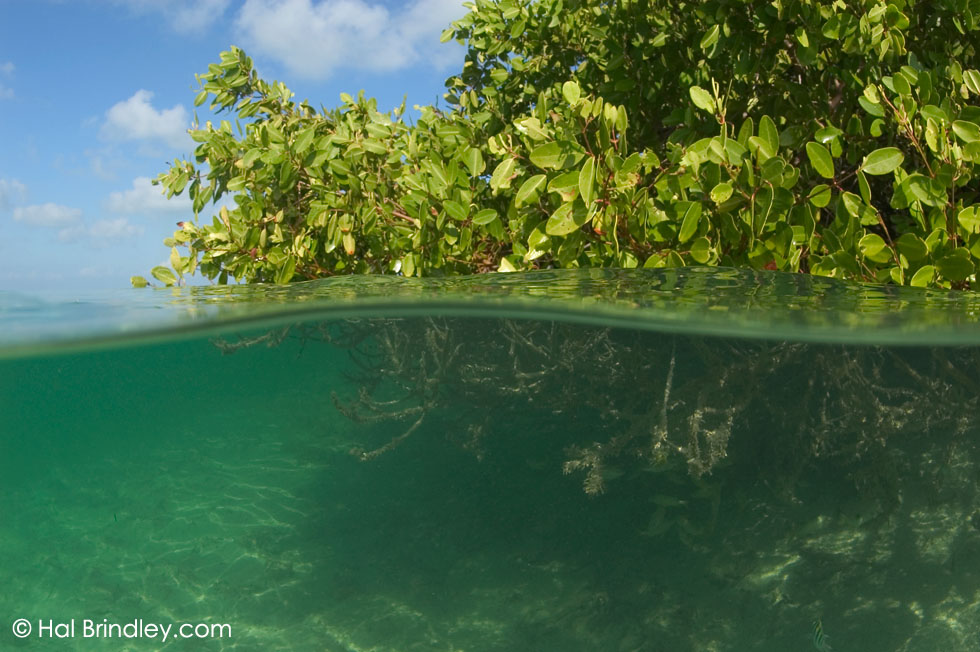
As a kid I always wished I could see Pterodactyls in flight. This is the closest I have come so far. It is the Magnificent Frigatebird.
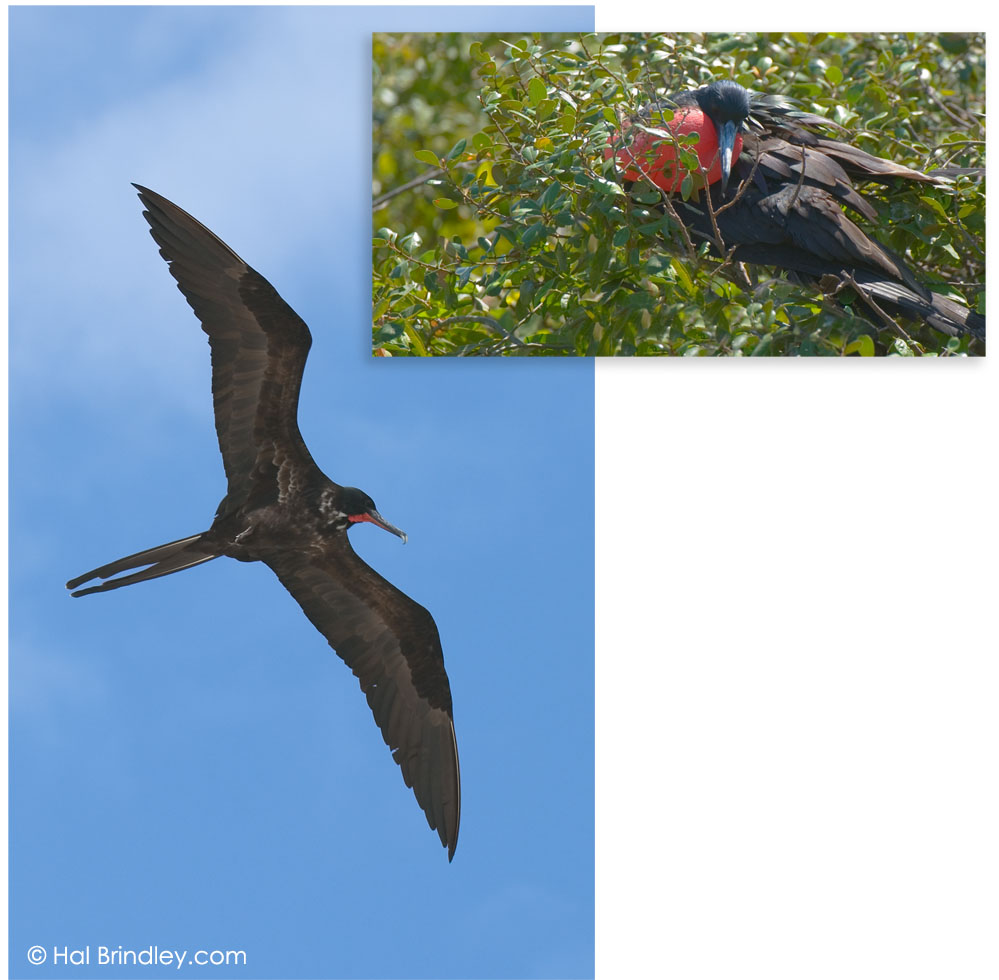
It has a wing span of seven and a half feet!
Guess how much this monstrous bird weighs? A miniscule 3.3 pounds.
It can soar endlessly and effortlessly, always over water but never landing at sea (it cannot take off again from the water).
Males have a red throat pouch they inflate during nesting displays.
If you heard someone say “there’s a colony across the island where you can see a lot of boobies” you might get pretty excited right? I know I did. Indeed, the inhabitants were not wearing any clothes but these were boobies of a type I had never before seen; Red-footed Boobies.
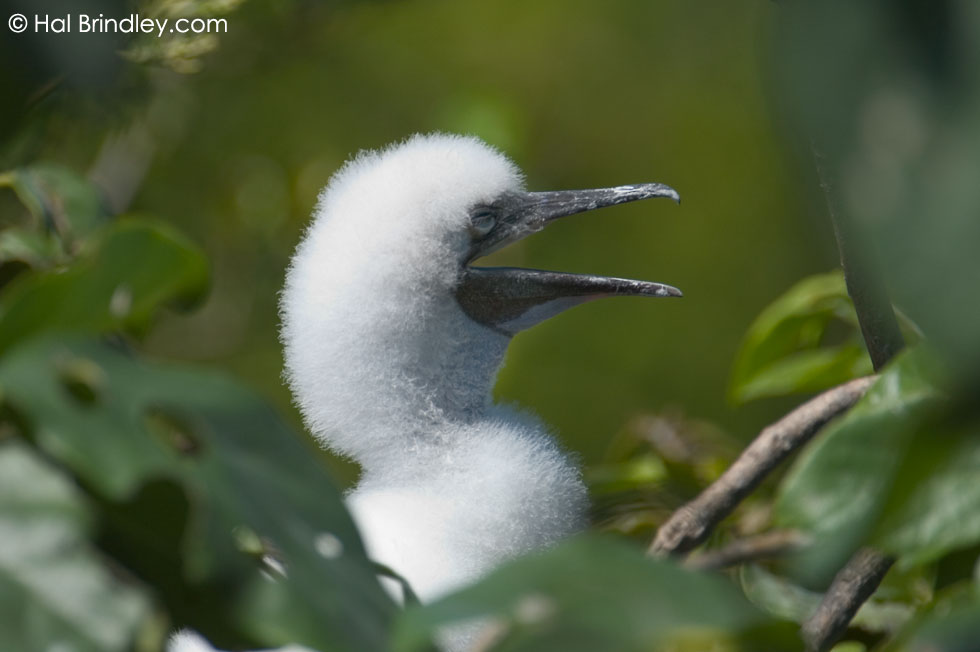
Half Moon Caye is the only nesting colony for the Red-footed Booby in all of Belize. I happened to be there at the right time of year to see some young chicks sunbathing at the booby colony.
We are now entering the jungle. The quiet twittering of birds floats down from the leafy canopy far above. Suddenly you hear a deep growl in the distance. The sound becomes louder and louder and rises to a fevered pitch of deep-throated bellowing roars.
The first thought that pops into your head is Jaguar. But this sound is too big. It must be a mutant 10 ft. werewolf agonizing through a painful, skin-stretching transformation from man to monster. The hair on the back of your neck stands up and you know you’re about to become lunch. When you finally realize it’s coming from a monkey you feel pretty stupid. This is a Yucatan Black Howler Monkey.

Howlers are the loudest land animal on the planet (only the Blue Whale is louder). A Howler’s roar can be heard over 3 miles away. Jinkees. This one is a baby. He won’t be howling for several years.
The Agouti is a fairly common resident of Central and South American forests. I hear it’s quite tasty although I’ve never successfully taken a bite out of one (they’re pretty darn fast).

This rodent has evolved to stand on its tippy toes (digitigrade) much like antelopes, and has very long legs; two adaptations for speed.
Let’s take a drive across the western border of Belize into the vast rainforests of Guatemala. Destination: Tikal, the ancient Maya city devoured by the jungle.
The most memorable part of the drive into Tikal National Park was the road signs. I am a collector of images of animal crossing signs from around the world and the road to Tikal was, for me, a wet dream. I saw a jaguar-crossing sign, turkey, deer, coati, and this one; snake-crossing.
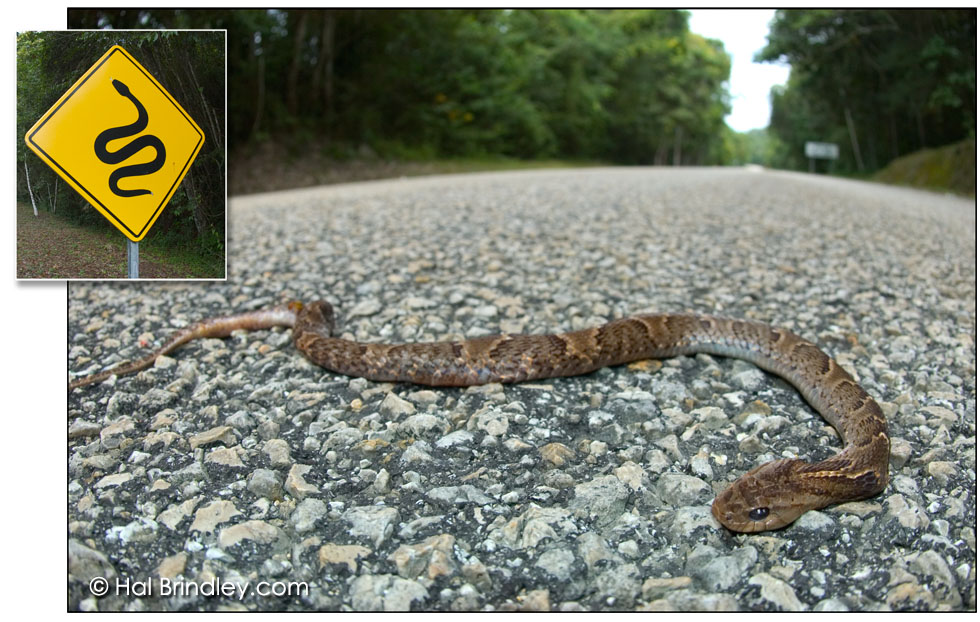
Obviously the signs are not 100% percent effective. Poor little buddy. (P.S. No, I didn’t hit this snake.)
Here is another one of my favorite moments from the journey. Walking at dusk in the rainforest near a massive stone temple, we suddenly find ourselves surrounded by a band of foraging White-nosed Coatis.

There are at least twenty, moving at a steady pace along the forest floor. Every so often they stop to dig a quick hole into which they jam their flexible snouts, searching for insects under the soil. Amazingly, the band shows almost no fear of me. The young lady in this photo actually touched the lens of my camera with her nose. It was incredible.
The locals would probably laugh at my excitement over an animal that is to them a common pest.
How do I know it’s a female? Because only the females travel in bands. The males are solitary. This is a unique social structure for a carnivore.
So you see, Coatis are very special.
This is something I didn’t expect to see in the rainforest: Turkeys.

There are only two species of turkey in the whole world: the Wild Turkey (AKA Thanksgiving dinner) and this flamboyant creature, the Ocellated Turkey.
It is only found in the Yucatan area of Central America. Pretty funky, huh?
And now for my grand finale. One of my favorite photos I’ve ever taken.
Shot deep in the heart of the Guatemalan jungle, in a dark tunnel beneath a 2,000 year old Maya temple,
brace yourself, it’s pretty scary…
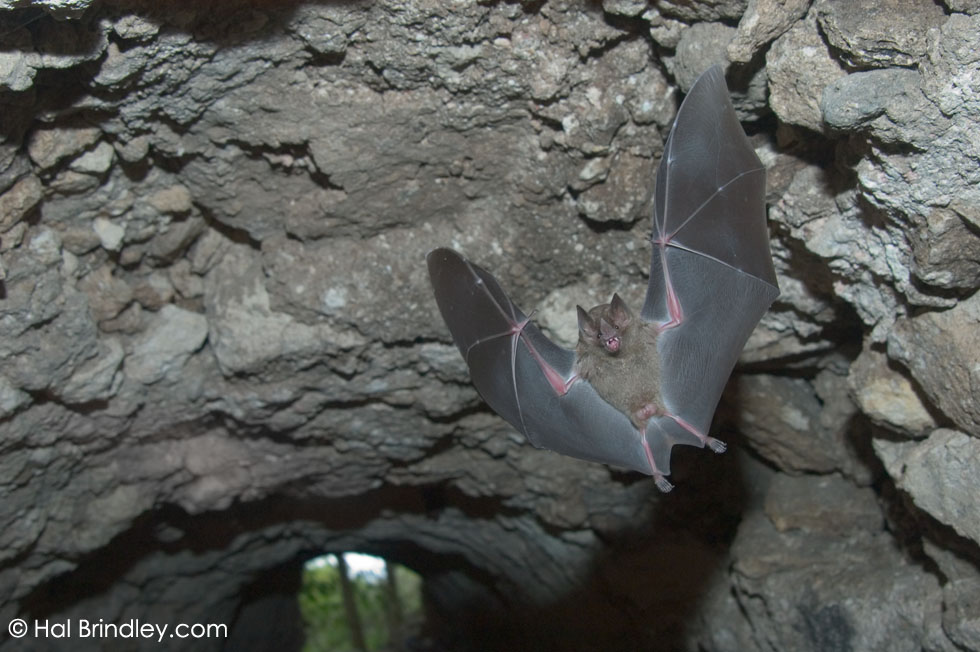
This is a Jamaican Fruit Bat, although fangs like these seem better suited to blood-sucking vampires.
Check out this close-up and I’ll explain how it happened.

It was pitch black in here and I had only a head lamp to light my way. There were a few bats hanging from the ceiling and they became agitated as I walked past. They began to fly back and forth along the length of the tunnel, making U-turns in front of my face. Since I had no hope of focusing in the dark, I pre-set my focus distance to about two feet and held my camera up in front of me. When a bat flew toward me I pushed the button, my flash momentarily illuminating the eerie scene like lightning on a stormy night.
After getting off a few shots I realized that the situation was probably a lot scarier for these little guys than for me. So I got the heck out of the tunnel and let them return to their nap.
Whew! That was intense.
I’ll conclude this journey with two portaits. On the left is one of my all time favorite critters, the national animal of Belize, the Baird’s Tapir. Since I didn’t manage to see one in the wild I’ve included a shot of a youngster in the Belize Zoo (where we got locked in and had to escape by 4-wheel-drive-mud-bogging, but that’s another story.)
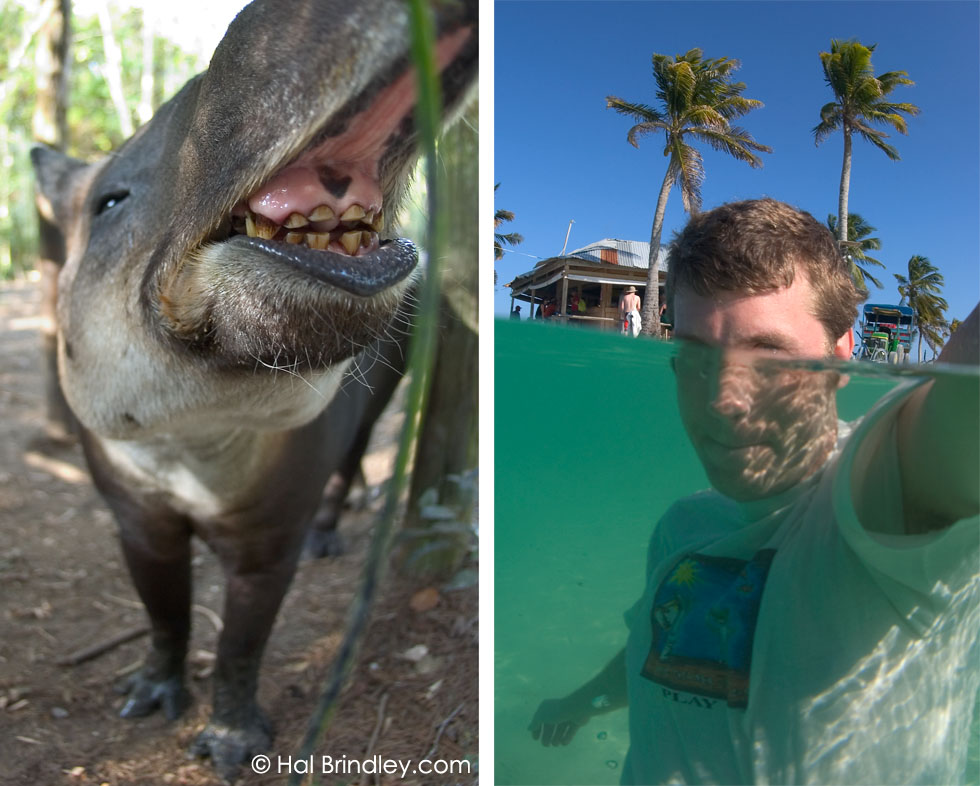
On the right is me up to my eyeballs in beautiful Belizean water. (Honestly I have no idea why those bubbles are coming out of my shorts.)
The End.
